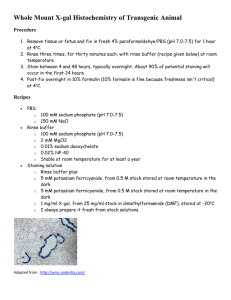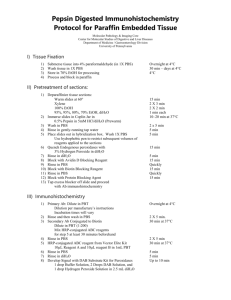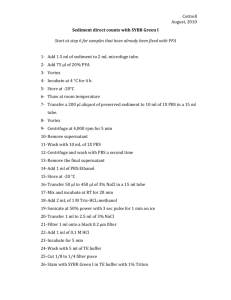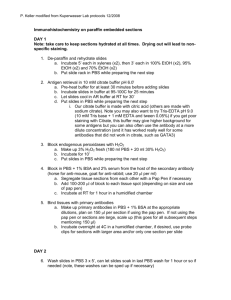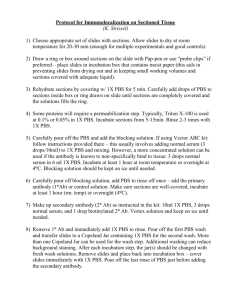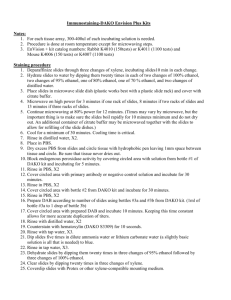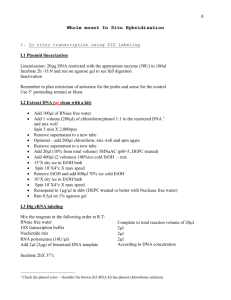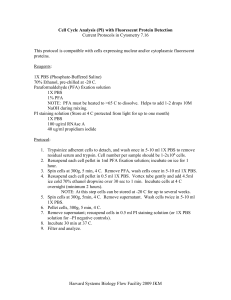Protocol for α
advertisement
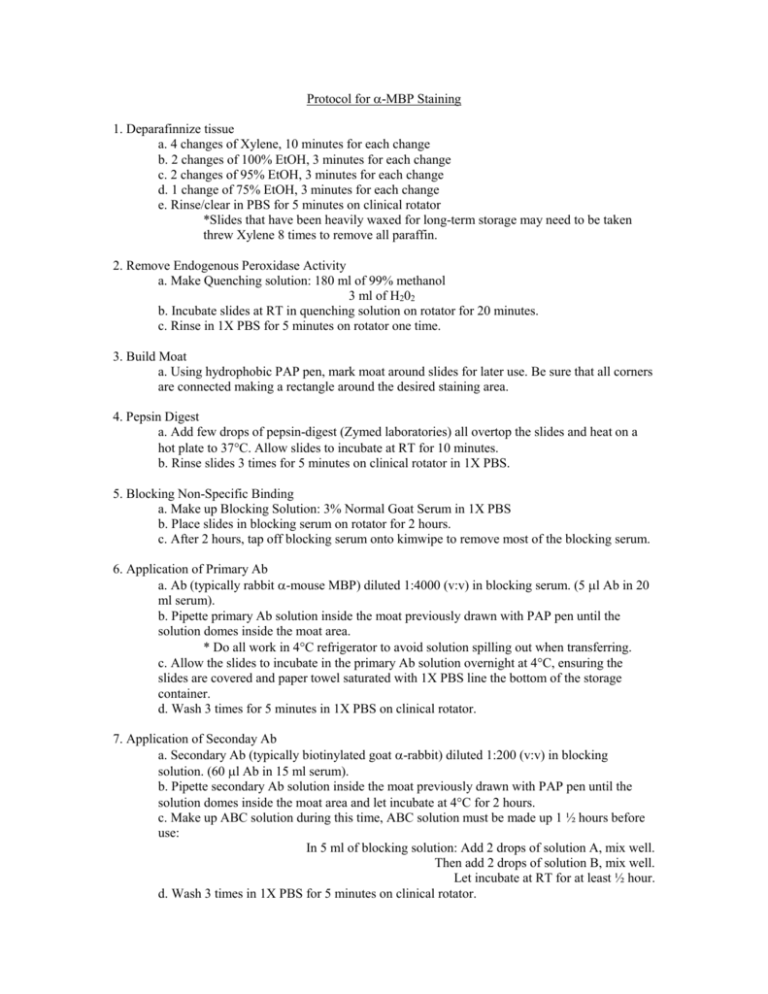
Protocol for -MBP Staining 1. Deparafinnize tissue a. 4 changes of Xylene, 10 minutes for each change b. 2 changes of 100% EtOH, 3 minutes for each change c. 2 changes of 95% EtOH, 3 minutes for each change d. 1 change of 75% EtOH, 3 minutes for each change e. Rinse/clear in PBS for 5 minutes on clinical rotator *Slides that have been heavily waxed for long-term storage may need to be taken threw Xylene 8 times to remove all paraffin. 2. Remove Endogenous Peroxidase Activity a. Make Quenching solution: 180 ml of 99% methanol 3 ml of H202 b. Incubate slides at RT in quenching solution on rotator for 20 minutes. c. Rinse in 1X PBS for 5 minutes on rotator one time. 3. Build Moat a. Using hydrophobic PAP pen, mark moat around slides for later use. Be sure that all corners are connected making a rectangle around the desired staining area. 4. Pepsin Digest a. Add few drops of pepsin-digest (Zymed laboratories) all overtop the slides and heat on a hot plate to 37C. Allow slides to incubate at RT for 10 minutes. b. Rinse slides 3 times for 5 minutes on clinical rotator in 1X PBS. 5. Blocking Non-Specific Binding a. Make up Blocking Solution: 3% Normal Goat Serum in 1X PBS b. Place slides in blocking serum on rotator for 2 hours. c. After 2 hours, tap off blocking serum onto kimwipe to remove most of the blocking serum. 6. Application of Primary Ab a. Ab (typically rabbit -mouse MBP) diluted 1:4000 (v:v) in blocking serum. (5 l Ab in 20 ml serum). b. Pipette primary Ab solution inside the moat previously drawn with PAP pen until the solution domes inside the moat area. * Do all work in 4C refrigerator to avoid solution spilling out when transferring. c. Allow the slides to incubate in the primary Ab solution overnight at 4C, ensuring the slides are covered and paper towel saturated with 1X PBS line the bottom of the storage container. d. Wash 3 times for 5 minutes in 1X PBS on clinical rotator. 7. Application of Seconday Ab a. Secondary Ab (typically biotinylated goat -rabbit) diluted 1:200 (v:v) in blocking solution. (60 l Ab in 15 ml serum). b. Pipette secondary Ab solution inside the moat previously drawn with PAP pen until the solution domes inside the moat area and let incubate at 4C for 2 hours. c. Make up ABC solution during this time, ABC solution must be made up 1 ½ hours before use: In 5 ml of blocking solution: Add 2 drops of solution A, mix well. Then add 2 drops of solution B, mix well. Let incubate at RT for at least ½ hour. d. Wash 3 times in 1X PBS for 5 minutes on clinical rotator. 8. Application of Complexing reagent (Vectastain ABC reagent) a. Apply ABC solution substrate (previously prepared) in moat until a dome forms overtop the slides. b. Allow slides to incubate at RT for 45 minutes. c. Rinse slides 3 times for 5 minutes on clinical rotator in 1X PBS. 9. Development of Colored Reaction Product If not using DAB Kit, skip down to ALTERNATE procedure Do not make up DAB reagent until just before use. a. Make up DAB solution from DAB kit: In 10 ml of DI H20 4 drops of pH 7.5 buffer, mix well. 8 drops of DAB reagent, mix well. 4 drops of H202 solution, mix well. 4 drops of Nickel solution, mix well. b. Place DAB solution inside moat of slides and allow to incubate for approximately 4 minutes. (Time for stain to develop is dependent on initial concentration of primary Ab, may take more or less time.) c. Rinse in IX PBS to stop color reaction development. d. Place slides in Nuclear Fast Red solution for 2 minutes. Stain is time-dependent. For darker staining, use a longer incubation time; for lighter stains, reduce incubation time. (See formula sheet to make up Nuclear Fast Red solution.) e. Wash thoroughly in DI water ~ 2 minutes while changing ALTERNATE Procedure a. Multiple solution need to be made up for the alternate procedure. See the attached formula sheet for instructions. The solutions needed are: * .1M Acetate buffer pH 6.0 * Tris/Saline buffer pH 7.6 * Tris-Cobalt solution pH 7.2 * .1% Nuclear Fast Red solution *NiDAB solution b. After all of the solutions has been prepared, incubate slides in the NiDAB solution for 5 minutes on a clinical rotator. If not staining is apparent on the positive control, this step can be repeated for darker staining. c. Rinse slides in the Tris buffer solution ~ 10 changes d. Incubate slides in the Tris-Cobalt solution for 4 minutes at RT on a clinical rotator. e. Rinse slides briefly in DI H20 ~ 5 changes f. Counterstain tissue in .1% Nuclear Fast Red solution for 2 minutes. Stain is timedependent. For darker staining, use a longer incubation time; for lighter stains, reduce incubation time. g. Wash thoroughly in DI H20 ~ 2 minutes while changing 10. Dehydration and Mounting a. One change of 70% EtOH ~ 20 dips b. Two changes of 95% EtOH ~ 20 dips c. Three changes of 100% EtOH ~ 20 dips d. Three changes of Xylene ~ 20 dips e. Coverslip with Permount Protocol for -MBP Staining 1. Deparafinnize tissue a. 4 changes of Xylene, 10 minutes for each change b. 2 changes of 100% EtOH ~ 10-20 dips c. 2 changes of 95% EtOH ~ 10-20 dips d. 1 change of 75% EtOH ~ 10-20 dips e. Rinse/clear in PBS for 5 minutes on clinical rotator *Slides that have been heavily waxed for long-term storage may need to be taken threw Xylene 8 times to remove all paraffin. f. 2. Remove Endogenous Peroxidase Activity a. Make Quenching solution: 180 ml of 99% methanol 3 ml of H202 b. Incubate slides at RT in quenching solution on rotator for 20 minutes. c. Rinse in 1X PBS for 5 minutes on rotator one time. 3. Build Moat a. Using hydrophobic PAP pen, mark moat around slides for later use. Be sure that all corners are connected making a rectangle around the desired staining area. 4. Pepsin Digest a. Add few drops of pepsin-digest (Zymed laboratories) all overtop the slides and heat on a hot plate to 37C. Allow slides to incubate at RT for 10 minutes. b. Rinse slides 3 times for 5 minutes on clinical rotator in 1X PBS. 5. Blocking Non-Specific Binding a. Make up Blocking Solution: 3% Normal Goat Serum in 1X PBS b. Place slides in blocking serum on rotator for 2 hours. c. After 2 hours, tap off blocking serum onto kimwipe to remove most of the blocking serum. 6. Application of Primary Ab a. Ab (typically rabbit -mouse MBP) diluted 1:4000 (v:v) in blocking serum. (5 l Ab in 20 ml serum). b. Pipette primary Ab solution inside the moat previously drawn with PAP pen until the solution domes inside the moat area. * Do all work in 4C refrigerator to avoid solution spilling out when transferring. c. Allow the slides to incubate in the primary Ab solution overnight at 4C, ensuring the slides are covered and paper towel saturated with 1X PBS line the bottom of the storage container. d. Wash 3 times for 5 minutes in 1X PBS on clinical rotator. 7. Application of Seconday Ab a. Secondary Ab (typically biotinylated goat -rabbit) diluted 1:200 (v:v) in blocking solution. (60 l Ab in 15 ml serum). b. Pipette secondary Ab solution inside the moat previously drawn with PAP pen until the solution domes inside the moat area and let incubate at 4C for 2 hours. c. Make up ABC solution during this time, ABC solution must be made up 1 ½ hours before use: In 5 ml of blocking solution: Add 2 drops of solution A, mix well. Then add 2 drops of solution B, mix well. Let incubate at RT for at least ½ hour. d. Wash 3 times in 1X PBS for 5 minutes on clinical rotator. 8. Application of Complexing reagent (Vectastain ABC reagent) a. Apply ABC solution substrate (previously prepared) in moat until a dome forms overtop the slides. b. Allow slides to incubate at RT for 45 minutes. c. Rinse slides 3 times for 5 minutes on clinical rotator in 1X PBS. 9. Development of Colored Reaction Product If not using DAB Kit, skip down to ALTERNATE procedure Do not make up DAB reagent until just before use. a. Make up DAB solution from DAB kit: In 10 ml of DI H20 4 drops of pH 7.5 buffer, mix well. 8 drops of DAB reagent, mix well. 4 drops of H202 solution, mix well. 4 drops of Nickel solution, mix well. b. Place DAB solution inside moat of slides and allow to incubate for approximately 4 minutes. (Time for stain to develop is dependent on initial concentration of primary Ab, may take more or less time.) c. Rinse in IX PBS to stop color reaction development. d. Place slides in Nuclear Fast Red solution for 2 minutes. Stain is time-dependent. For darker staining, use a longer incubation time; for lighter stains, reduce incubation time. (See formula sheet to make up Nuclear Fast Red solution.) e. Wash thoroughly in DI water ~ 2 minutes while changing ALTERNATE Procedure b. Multiple solution need to be made up for the alternate procedure. See the attached formula sheet for instructions. The solutions needed are: * .1M Acetate buffer pH 6.0 * Tris/Saline buffer pH 7.6 * Tris-Cobalt solution pH 7.2 * .1% Nuclear Fast Red solution *NiDAB solution b. After all of the solutions has been prepared, incubate slides in the NiDAB solution for 5 minutes on a clinical rotator. If not staining is apparent on the positive control, this step can be repeated for darker staining. c. Rinse slides in the Tris buffer solution ~ 10 changes d. Incubate slides in the Tris-Cobalt solution for 4 minutes at RT on a clinical rotator. e. Rinse slides briefly in DI H20 ~ 5 changes f. Counterstain tissue in .1% Nuclear Fast Red solution for 2 minutes. Stain is timedependent. For darker staining, use a longer incubation time; for lighter stains, reduce incubation time. g. Wash thoroughly in DI H20 ~ 2 minutes while changing 10. Dehydration and Mounting a. One change of 70% EtOH ~ 20 dips b. Two changes of 95% EtOH ~ 20 dips c. Three changes of 100% EtOH ~ 20 dips d. Three changes of Xylene ~ 20 dips e. Coverslip with Permount
